Characteristic of TEM EDX
- 格式:ppt
- 大小:725.50 KB
- 文档页数:10
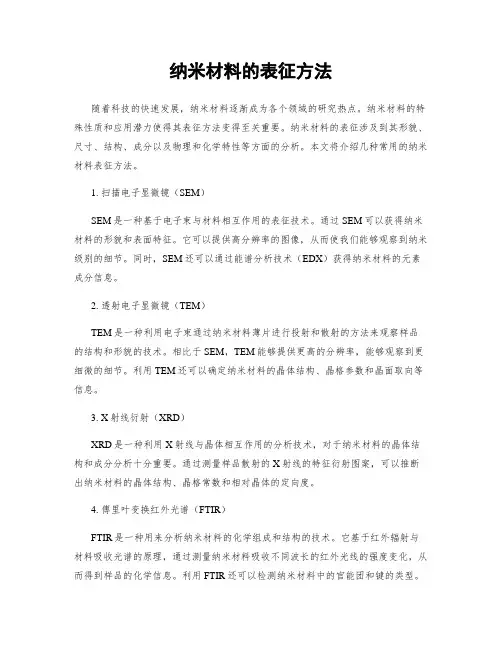
纳米材料的表征方法随着科技的快速发展,纳米材料逐渐成为各个领域的研究热点。
纳米材料的特殊性质和应用潜力使得其表征方法变得至关重要。
纳米材料的表征涉及到其形貌、尺寸、结构、成分以及物理和化学特性等方面的分析。
本文将介绍几种常用的纳米材料表征方法。
1. 扫描电子显微镜(SEM)SEM是一种基于电子束与材料相互作用的表征技术。
通过SEM可以获得纳米材料的形貌和表面特征。
它可以提供高分辨率的图像,从而使我们能够观察到纳米级别的细节。
同时,SEM还可以通过能谱分析技术(EDX)获得纳米材料的元素成分信息。
2. 透射电子显微镜(TEM)TEM是一种利用电子束通过纳米材料薄片进行投射和散射的方法来观察样品的结构和形貌的技术。
相比于SEM,TEM能够提供更高的分辨率,能够观察到更细微的细节。
利用TEM还可以确定纳米材料的晶体结构、晶格参数和晶面取向等信息。
3. X射线衍射(XRD)XRD是一种利用X射线与晶体相互作用的分析技术,对于纳米材料的晶体结构和成分分析十分重要。
通过测量样品散射的X射线的特征衍射图案,可以推断出纳米材料的晶体结构、晶格常数和相对晶体的定向度。
4. 傅里叶变换红外光谱(FTIR)FTIR是一种用来分析纳米材料的化学组成和结构的技术。
它基于红外辐射与材料吸收光谱的原理,通过测量纳米材料吸收不同波长的红外光线的强度变化,从而得到样品的化学信息。
利用FTIR还可以检测纳米材料中的官能团和键的类型。
5. 激光粒度仪激光粒度仪是一种常用的用于测量纳米材料粒径分布的仪器。
它通过测量光散射的强度来确定样品中颗粒的尺寸分布。
激光粒度仪不仅可以提供纳米材料的平均粒径,还可以分析其尺寸分布的均匀性,从而对纳米材料的制备工艺进行优化。
除了以上介绍的几种常用的纳米材料表征方法,还有许多其他的技术可供选择,如原子力显微镜(AFM)、拉曼光谱、热重分析(TGA)等。
选择适合的表征方法需要根据具体的研究目的和所要分析的属性来确定。

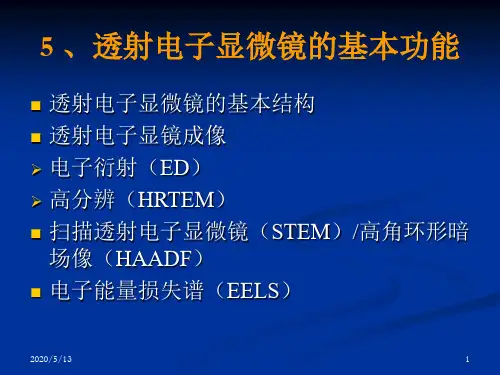
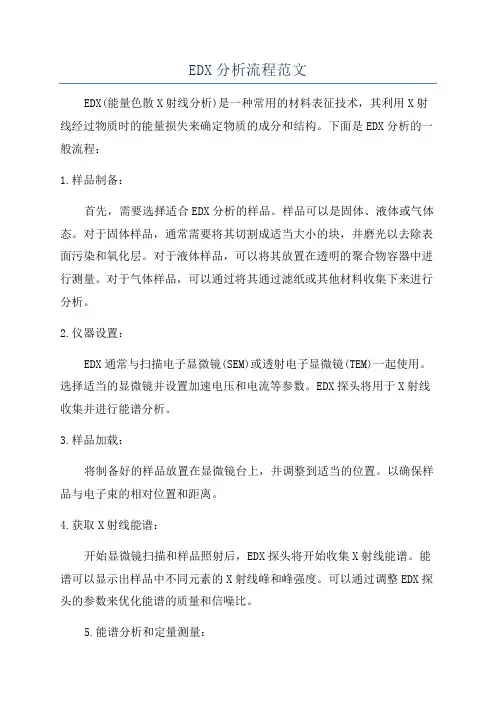
EDX分析流程范文EDX(能量色散X射线分析)是一种常用的材料表征技术,其利用X射线经过物质时的能量损失来确定物质的成分和结构。
下面是EDX分析的一般流程:1.样品制备:首先,需要选择适合EDX分析的样品。
样品可以是固体、液体或气体态。
对于固体样品,通常需要将其切割成适当大小的块,并磨光以去除表面污染和氧化层。
对于液体样品,可以将其放置在透明的聚合物容器中进行测量。
对于气体样品,可以通过将其通过滤纸或其他材料收集下来进行分析。
2.仪器设置:EDX通常与扫描电子显微镜(SEM)或透射电子显微镜(TEM)一起使用。
选择适当的显微镜并设置加速电压和电流等参数。
EDX探头将用于X射线收集并进行能谱分析。
3.样品加载:将制备好的样品放置在显微镜台上,并调整到适当的位置。
以确保样品与电子束的相对位置和距离。
4.获取X射线能谱:开始显微镜扫描和样品照射后,EDX探头将开始收集X射线能谱。
能谱可以显示出样品中不同元素的X射线峰和峰强度。
可以通过调整EDX探头的参数来优化能谱的质量和信噪比。
5.能谱分析和定量测量:通过分析能谱的峰形和峰强度,可以确定出样品中存在的元素,并通过比对标准峰数据库来进一步确认元素的身份。
利用能谱的峰强度可以进行定量测量,计算出不同元素的相对或绝对含量。
6.数据处理和解释:对于复杂样品,可能需要进行数据处理和解释,例如通过比对标准样品来确定未知样品中的元素含量。
还可以利用衍射技术和其他相关技术进行样品的结构和形貌分析。
总结:EDX分析流程包括样品制备、仪器设置、样品加载、X射线能谱获取、能谱分析和定量测量、数据处理和解释等几个步骤。
通过这些步骤,可以获得样品中不同元素的含量和分布信息,从而进行材料表征和分析。
EDX分析在材料科学、生命科学、地质学等领域都有广泛应用。

1、选择元素(markers下选择的伪彩图为应该含有全部元素的伪彩图,此时也应该包括Cu,ROI里面出来伪彩图为所分析的伪彩图)、点击automap的generate out,得到以下伪彩图(以钯负载的丝光沸石为例)
在上面选择后点击中的Generate output,即可以得到伪彩图。
如下图所示
2、点击工具栏的方框,框中HAADF,双击方框,输入实际扫描时的点数(本次实验是20*20,图1所示),点Sum选项中的integrate,得到选中区域的EDX图(图2);
图1 输入实际扫描的分辨率
图2 HAADF分析的EDX图。
3、删除原先机器给出的EDX图,剩余Integrate的EDX图(图2),点击Sum选项中的integrate,选择Log中的数据,复制到Word,字体大小12,即得到Integrate的EDX图的元素积分(表1所示);
表1、Integrate积分得到的元素分析表
**Quantification Results***
Correction method: None
Detector
Element Weight % Atomic % Uncert. % Correction k-Factor ------- -------- -------- --------- ---------- -------- C(K) 3.36 5.48 0.24 0.26 3.940
O(K) 51.45 62.95 0.47 0.49 1.974
Al(K) 4.14 3.00 0.11 0.92 1.027
Si(K) 40.92 28.52 0.30 0.92 1.000
Pd(K) 0.11 0.02 0.16 0.98 6.031。

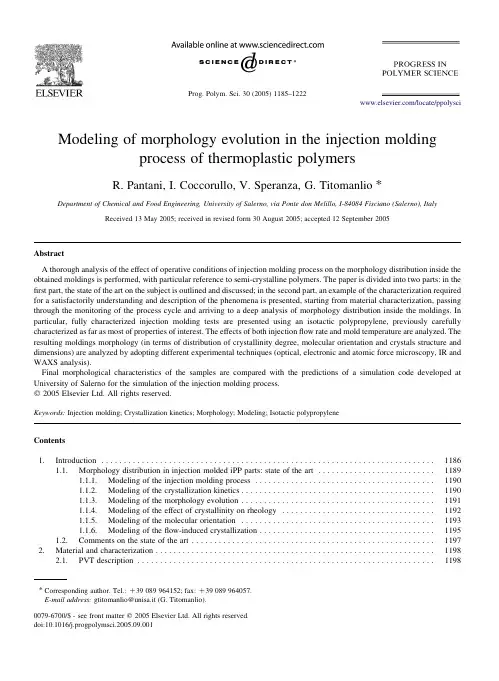
Modeling of morphology evolution in the injection moldingprocess of thermoplastic polymersR.Pantani,I.Coccorullo,V.Speranza,G.Titomanlio* Department of Chemical and Food Engineering,University of Salerno,via Ponte don Melillo,I-84084Fisciano(Salerno),Italy Received13May2005;received in revised form30August2005;accepted12September2005AbstractA thorough analysis of the effect of operative conditions of injection molding process on the morphology distribution inside the obtained moldings is performed,with particular reference to semi-crystalline polymers.The paper is divided into two parts:in the first part,the state of the art on the subject is outlined and discussed;in the second part,an example of the characterization required for a satisfactorily understanding and description of the phenomena is presented,starting from material characterization,passing through the monitoring of the process cycle and arriving to a deep analysis of morphology distribution inside the moldings.In particular,fully characterized injection molding tests are presented using an isotactic polypropylene,previously carefully characterized as far as most of properties of interest.The effects of both injectionflow rate and mold temperature are analyzed.The resulting moldings morphology(in terms of distribution of crystallinity degree,molecular orientation and crystals structure and dimensions)are analyzed by adopting different experimental techniques(optical,electronic and atomic force microscopy,IR and WAXS analysis).Final morphological characteristics of the samples are compared with the predictions of a simulation code developed at University of Salerno for the simulation of the injection molding process.q2005Elsevier Ltd.All rights reserved.Keywords:Injection molding;Crystallization kinetics;Morphology;Modeling;Isotactic polypropyleneContents1.Introduction (1186)1.1.Morphology distribution in injection molded iPP parts:state of the art (1189)1.1.1.Modeling of the injection molding process (1190)1.1.2.Modeling of the crystallization kinetics (1190)1.1.3.Modeling of the morphology evolution (1191)1.1.4.Modeling of the effect of crystallinity on rheology (1192)1.1.5.Modeling of the molecular orientation (1193)1.1.6.Modeling of theflow-induced crystallization (1195)ments on the state of the art (1197)2.Material and characterization (1198)2.1.PVT description (1198)*Corresponding author.Tel.:C39089964152;fax:C39089964057.E-mail address:gtitomanlio@unisa.it(G.Titomanlio).2.2.Quiescent crystallization kinetics (1198)2.3.Viscosity (1199)2.4.Viscoelastic behavior (1200)3.Injection molding tests and analysis of the moldings (1200)3.1.Injection molding tests and sample preparation (1200)3.2.Microscopy (1202)3.2.1.Optical microscopy (1202)3.2.2.SEM and AFM analysis (1202)3.3.Distribution of crystallinity (1202)3.3.1.IR analysis (1202)3.3.2.X-ray analysis (1203)3.4.Distribution of molecular orientation (1203)4.Analysis of experimental results (1203)4.1.Injection molding tests (1203)4.2.Morphology distribution along thickness direction (1204)4.2.1.Optical microscopy (1204)4.2.2.SEM and AFM analysis (1204)4.3.Morphology distribution alongflow direction (1208)4.4.Distribution of crystallinity (1210)4.4.1.Distribution of crystallinity along thickness direction (1210)4.4.2.Crystallinity distribution alongflow direction (1212)4.5.Distribution of molecular orientation (1212)4.5.1.Orientation along thickness direction (1212)4.5.2.Orientation alongflow direction (1213)4.5.3.Direction of orientation (1214)5.Simulation (1214)5.1.Pressure curves (1215)5.2.Morphology distribution (1215)5.3.Molecular orientation (1216)5.3.1.Molecular orientation distribution along thickness direction (1216)5.3.2.Molecular orientation distribution alongflow direction (1216)5.3.3.Direction of orientation (1217)5.4.Crystallinity distribution (1217)6.Conclusions (1217)References (1219)1.IntroductionInjection molding is one of the most widely employed methods for manufacturing polymeric products.Three main steps are recognized in the molding:filling,packing/holding and cooling.During thefilling stage,a hot polymer melt rapidlyfills a cold mold reproducing a cavity of the desired product shape. During the packing/holding stage,the pressure is raised and extra material is forced into the mold to compensate for the effects that both temperature decrease and crystallinity development determine on density during solidification.The cooling stage starts at the solidification of a thin section at cavity entrance (gate),starting from that instant no more material can enter or exit from the mold impression and holding pressure can be released.When the solid layer on the mold surface reaches a thickness sufficient to assure required rigidity,the product is ejected from the mold.Due to the thermomechanical history experienced by the polymer during processing,macromolecules in injection-molded objects present a local order.This order is referred to as‘morphology’which literally means‘the study of the form’where form stands for the shape and arrangement of parts of the object.When referred to polymers,the word morphology is adopted to indicate:–crystallinity,which is the relative volume occupied by each of the crystalline phases,including mesophases;–dimensions,shape,distribution and orientation of the crystallites;–orientation of amorphous phase.R.Pantani et al./Prog.Polym.Sci.30(2005)1185–1222 1186R.Pantani et al./Prog.Polym.Sci.30(2005)1185–12221187Apart from the scientific interest in understandingthe mechanisms leading to different order levels inside a polymer,the great technological importance of morphology relies on the fact that polymer character-istics (above all mechanical,but also optical,electrical,transport and chemical)are to a great extent affected by morphology.For instance,crystallinity has a pro-nounced effect on the mechanical properties of the bulk material since crystals are generally stiffer than amorphous material,and also orientation induces anisotropy and other changes in mechanical properties.In this work,a thorough analysis of the effect of injection molding operative conditions on morphology distribution in moldings with particular reference to crystalline materials is performed.The aim of the paper is twofold:first,to outline the state of the art on the subject;second,to present an example of the characterization required for asatisfactorilyR.Pantani et al./Prog.Polym.Sci.30(2005)1185–12221188understanding and description of the phenomena, starting from material description,passing through the monitoring of the process cycle and arriving to a deep analysis of morphology distribution inside the mold-ings.To these purposes,fully characterized injection molding tests were performed using an isotactic polypropylene,previously carefully characterized as far as most of properties of interest,in particular quiescent nucleation density,spherulitic growth rate and rheological properties(viscosity and relaxation time)were determined.The resulting moldings mor-phology(in terms of distribution of crystallinity degree, molecular orientation and crystals structure and dimensions)was analyzed by adopting different experimental techniques(optical,electronic and atomic force microscopy,IR and WAXS analysis).Final morphological characteristics of the samples were compared with the predictions of a simulation code developed at University of Salerno for the simulation of the injection molding process.The effects of both injectionflow rate and mold temperature were analyzed.1.1.Morphology distribution in injection molded iPP parts:state of the artFrom many experimental observations,it is shown that a highly oriented lamellar crystallite microstructure, usually referred to as‘skin layer’forms close to the surface of injection molded articles of semi-crystalline polymers.Far from the wall,the melt is allowed to crystallize three dimensionally to form spherulitic structures.Relative dimensions and morphology of both skin and core layers are dependent on local thermo-mechanical history,which is characterized on the surface by high stress levels,decreasing to very small values toward the core region.As a result,the skin and the core reveal distinct characteristics across the thickness and also along theflow path[1].Structural and morphological characterization of the injection molded polypropylene has attracted the interest of researchers in the past three decades.In the early seventies,Kantz et al.[2]studied the morphology of injection molded iPP tensile bars by using optical microscopy and X-ray diffraction.The microscopic results revealed the presence of three distinct crystalline zones on the cross-section:a highly oriented non-spherulitic skin;a shear zone with molecular chains oriented essentially parallel to the injection direction;a spherulitic core with essentially no preferred orientation.The X-ray diffraction studies indicated that the skin layer contains biaxially oriented crystallites due to the biaxial extensionalflow at theflow front.A similar multilayered morphology was also reported by Menges et al.[3].Later on,Fujiyama et al.[4] investigated the skin–core morphology of injection molded iPP samples using X-ray Small and Wide Angle Scattering techniques,and suggested that the shear region contains shish–kebab structures.The same shish–kebab structure was observed by Wenig and Herzog in the shear region of their molded samples[5].A similar investigation was conducted by Titomanlio and co-workers[6],who analyzed the morphology distribution in injection moldings of iPP. They observed a skin–core morphology distribution with an isotropic spherulitic core,a skin layer characterized by afine crystalline structure and an intermediate layer appearing as a dark band in crossed polarized light,this layer being characterized by high crystallinity.Kalay and Bevis[7]pointed out that,although iPP crystallizes essentially in the a-form,a small amount of b-form can be found in the skin layer and in the shear region.The amount of b-form was found to increase by effect of high shear rates[8].A wide analysis on the effect of processing conditions on the morphology of injection molded iPP was conducted by Viana et al.[9]and,more recently, by Mendoza et al.[10].In particular,Mendoza et al. report that the highest level of crystallinity orientation is found inside the shear zone and that a high level of orientation was also found in the skin layer,with an orientation angle tilted toward the core.It is rather difficult to theoretically establish the relationship between the observed microstructure and processing conditions.Indeed,a model of the injection molding process able to predict morphology distribution in thefinal samples is not yet available,even if it would be of enormous strategic importance.This is mainly because a complete understanding of crystallization kinetics in processing conditions(high cooling rates and pressures,strong and complexflowfields)has not yet been reached.In this section,the most relevant aspects for process modeling and morphology development are identified. In particular,a successful path leading to a reliable description of morphology evolution during polymer processing should necessarily pass through:–a good description of morphology evolution under quiescent conditions(accounting all competing crystallization processes),including the range of cooling rates characteristic of processing operations (from1to10008C/s);R.Pantani et al./Prog.Polym.Sci.30(2005)1185–12221189–a description capturing the main features of melt morphology(orientation and stretch)evolution under processing conditions;–a good coupling of the two(quiescent crystallization and orientation)in order to capture the effect of crystallinity on viscosity and the effect offlow on crystallization kinetics.The points listed above outline the strategy to be followed in order to achieve the basic understanding for a satisfactory description of morphology evolution during all polymer processing operations.In the following,the state of art for each of those points will be analyzed in a dedicated section.1.1.1.Modeling of the injection molding processThefirst step in the prediction of the morphology distribution within injection moldings is obviously the thermo-mechanical simulation of the process.Much of the efforts in the past were focused on the prediction of pressure and temperature evolution during the process and on the prediction of the melt front advancement [11–15].The simulation of injection molding involves the simultaneous solution of the mass,energy and momentum balance equations.Thefluid is non-New-tonian(and viscoelastic)with all parameters dependent upon temperature,pressure,crystallinity,which are all function of pressibility cannot be neglected as theflow during the packing/holding step is determined by density changes due to temperature, pressure and crystallinity evolution.Indeed,apart from some attempts to introduce a full 3D approach[16–19],the analysis is currently still often restricted to the Hele–Shaw(or thinfilm) approximation,which is warranted by the fact that most injection molded parts have the characteristic of being thin.Furthermore,it is recognized that the viscoelastic behavior of the polymer only marginally influences theflow kinematics[20–22]thus the melt is normally considered as a non-Newtonian viscousfluid for the description of pressure and velocity gradients evolution.Some examples of adopting a viscoelastic constitutive equation in the momentum balance equations are found in the literature[23],but the improvements in accuracy do not justify a considerable extension of computational effort.It has to be mentioned that the analysis of some features of kinematics and temperature gradients affecting the description of morphology need a more accurate description with respect to the analysis of pressure distributions.Some aspects of the process which were often neglected and may have a critical importance are the description of the heat transfer at polymer–mold interface[24–26]and of the effect of mold deformation[24,27,28].Another aspect of particular interest to the develop-ment of morphology is the fountainflow[29–32], which is often neglected being restricted to a rather small region at theflow front and close to the mold walls.1.1.2.Modeling of the crystallization kineticsIt is obvious that the description of crystallization kinetics is necessary if thefinal morphology of the molded object wants to be described.Also,the development of a crystalline degree during the process influences the evolution of all material properties like density and,above all,viscosity(see below).Further-more,crystallization kinetics enters explicitly in the generation term of the energy balance,through the latent heat of crystallization[26,33].It is therefore clear that the crystallinity degree is not only a result of simulation but also(and above all)a phenomenon to be kept into account in each step of process modeling.In spite of its dramatic influence on the process,the efforts to simulate the injection molding of semi-crystalline polymers are crude in most of the commercial software for processing simulation and rather scarce in the fleur and Kamal[34],Papatanasiu[35], Titomanlio et al.[15],Han and Wang[36],Ito et al.[37],Manzione[38],Guo and Isayev[26],and Hieber [25]adopted the following equation(Kolmogoroff–Avrami–Evans,KAE)to predict the development of crystallinityd xd tZð1K xÞd d cd t(1)where x is the relative degree of crystallization;d c is the undisturbed volume fraction of the crystals(if no impingement would occur).A significant improvement in the prediction of crystallinity development was introduced by Titoman-lio and co-workers[39]who kept into account the possibility of the formation of different crystalline phases.This was done by assuming a parallel of several non-interacting kinetic processes competing for the available amorphous volume.The evolution of each phase can thus be described byd x id tZð1K xÞd d c id t(2)where the subscript i stands for a particular phase,x i is the relative degree of crystallization,x ZPix i and d c iR.Pantani et al./Prog.Polym.Sci.30(2005)1185–1222 1190is the expectancy of volume fraction of each phase if no impingement would occur.Eq.(2)assumes that,for each phase,the probability of the fraction increase of a single crystalline phase is simply the product of the rate of growth of the corresponding undisturbed volume fraction and of the amount of available amorphous fraction.By summing up the phase evolution equations of all phases(Eq.(2))over the index i,and solving the resulting differential equation,one simply obtainsxðtÞZ1K exp½K d cðtÞ (3)where d c Z Pid c i and Eq.(1)is recovered.It was shown by Coccorullo et al.[40]with reference to an iPP,that the description of the kinetic competition between phases is crucial to a reliable prediction of solidified structures:indeed,it is not possible to describe iPP crystallization kinetics in the range of cooling rates of interest for processing(i.e.up to several hundreds of8C/s)if the mesomorphic phase is neglected:in the cooling rate range10–1008C/s, spherulite crystals in the a-phase are overcome by the formation of the mesophase.Furthermore,it has been found that in some conditions(mainly at pressures higher than100MPa,and low cooling rates),the g-phase can also form[41].In spite of this,the presence of different crystalline phases is usually neglected in the literature,essentially because the range of cooling rates investigated for characterization falls in the DSC range (well lower than typical cooling rates of interest for the process)and only one crystalline phase is formed for iPP at low cooling rates.It has to be noticed that for iPP,which presents a T g well lower than ambient temperature,high values of crystallinity degree are always found in solids which passed through ambient temperature,and the cooling rate can only determine which crystalline phase forms, roughly a-phase at low cooling rates(below about 508C/s)and mesomorphic phase at higher cooling rates.The most widespread approach to the description of kinetic constant is the isokinetic approach introduced by Nakamura et al.According to this model,d c in Eq.(1)is calculated asd cðtÞZ ln2ðt0KðTðsÞÞd s2 435n(4)where K is the kinetic constant and n is the so-called Avrami index.When introduced as in Eq.(4),the reciprocal of the kinetic constant is a characteristic time for crystallization,namely the crystallization half-time, t05.If a polymer is cooled through the crystallization temperature,crystallization takes place at the tempera-ture at which crystallization half-time is of the order of characteristic cooling time t q defined ast q Z D T=q(5) where q is the cooling rate and D T is a temperature interval over which the crystallization kinetic constant changes of at least one order of magnitude.The temperature dependence of the kinetic constant is modeled using some analytical function which,in the simplest approach,is described by a Gaussian shaped curve:KðTÞZ K0exp K4ln2ðT K T maxÞ2D2(6)The following Hoffman–Lauritzen expression[42] is also commonly adopted:K½TðtÞ Z K0exp KUÃR$ðTðtÞK T NÞ!exp KKÃ$ðTðtÞC T mÞ2TðtÞ2$ðT m K TðtÞÞð7ÞBoth equations describe a bell shaped curve with a maximum which for Eq.(6)is located at T Z T max and for Eq.(7)lies at a temperature between T m(the melting temperature)and T N(which is classically assumed to be 308C below the glass transition temperature).Accord-ing to Eq.(7),the kinetic constant is exactly zero at T Z T m and at T Z T N,whereas Eq.(6)describes a reduction of several orders of magnitude when the temperature departs from T max of a value higher than2D.It is worth mentioning that only three parameters are needed for Eq.(6),whereas Eq.(7)needs the definition offive parameters.Some authors[43,44]couple the above equations with the so-called‘induction time’,which can be defined as the time the crystallization process starts, when the temperature is below the equilibrium melting temperature.It is normally described as[45]Dt indDtZðT0m K TÞat m(8)where t m,T0m and a are material constants.It should be mentioned that it has been found[46,47]that there is no need to explicitly incorporate an induction time when the modeling is based upon the KAE equation(Eq.(1)).1.1.3.Modeling of the morphology evolutionDespite of the fact that the approaches based on Eq.(4)do represent a significant step toward the descriptionR.Pantani et al./Prog.Polym.Sci.30(2005)1185–12221191of morphology,it has often been pointed out in the literature that the isokinetic approach on which Nakamura’s equation (Eq.(4))is based does not describe details of structure formation [48].For instance,the well-known experience that,with many polymers,the number of spherulites in the final solid sample increases strongly with increasing cooling rate,is indeed not taken into account by this approach.Furthermore,Eq.(4)describes an increase of crystal-linity (at constant temperature)depending only on the current value of crystallinity degree itself,whereas it is expected that the crystallization rate should depend also on the number of crystalline entities present in the material.These limits are overcome by considering the crystallization phenomenon as the consequence of nucleation and growth.Kolmogoroff’s model [49],which describes crystallinity evolution accounting of the number of nuclei per unit volume and spherulitic growth rate can then be applied.In this case,d c in Eq.(1)is described asd ðt ÞZ C m ðt 0d N ðs Þd s$ðt sG ðu Þd u 2435nd s (9)where C m is a shape factor (C 3Z 4/3p ,for spherical growth),G (T (t ))is the linear growth rate,and N (T (t ))is the nucleation density.The following Hoffman–Lauritzen expression is normally adopted for the growth rateG ½T ðt Þ Z G 0exp KUR $ðT ðt ÞK T N Þ!exp K K g $ðT ðt ÞC T m Þ2T ðt Þ2$ðT m K T ðt ÞÞð10ÞEqs.(7)and (10)have the same form,however the values of the constants are different.The nucleation mechanism can be either homo-geneous or heterogeneous.In the case of heterogeneous nucleation,two equations are reported in the literature,both describing the nucleation density as a function of temperature [37,50]:N ðT ðt ÞÞZ N 0exp ½j $ðT m K T ðt ÞÞ (11)N ðT ðt ÞÞZ N 0exp K 3$T mT ðt ÞðT m K T ðt ÞÞ(12)In the case of homogeneous nucleation,the nucleation rate rather than the nucleation density is function of temperature,and a Hoffman–Lauritzen expression isadoptedd N ðT ðt ÞÞd t Z N 0exp K C 1ðT ðt ÞK T N Þ!exp KC 2$ðT ðt ÞC T m ÞT ðt Þ$ðT m K T ðt ÞÞð13ÞConcentration of nucleating particles is usually quite significant in commercial polymers,and thus hetero-geneous nucleation becomes the dominant mechanism.When Kolmogoroff’s approach is followed,the number N a of active nuclei at the end of the crystal-lization process can be calculated as [48]N a ;final Zðt final 0d N ½T ðs Þd sð1K x ðs ÞÞd s (14)and the average dimension of crystalline structures can be attained by geometrical considerations.Pantani et al.[51]and Zuidema et al.[22]exploited this method to describe the distribution of crystallinity and the final average radius of the spherulites in injection moldings of polypropylene;in particular,they adopted the following equationR Z ffiffiffiffiffiffiffiffiffiffiffiffiffiffiffiffiffiffiffi3x a ;final 4p N a ;final 3s (15)A different approach is also present in the literature,somehow halfway between Nakamura’s and Kolmo-goroff’s models:the growth rate (G )and the kinetic constant (K )are described independently,and the number of active nuclei (and consequently the average dimensions of crystalline entities)can be obtained by coupling Eqs.(4)and (9)asN a ðT ÞZ 3ln 24p K ðT ÞG ðT Þ 3(16)where heterogeneous nucleation and spherical growth is assumed (Avrami’s index Z 3).Guo et al.[43]adopted this approach to describe the dimensions of spherulites in injection moldings of polypropylene.1.1.4.Modeling of the effect of crystallinity on rheology As mentioned above,crystallization has a dramatic influence on material viscosity.This phenomenon must obviously be taken into account and,indeed,the solidification of a semi-crystalline material is essen-tially caused by crystallization rather than by tempera-ture in normal processing conditions.Despite of the importance of the subject,the relevant literature on the effect of crystallinity on viscosity isR.Pantani et al./Prog.Polym.Sci.30(2005)1185–12221192rather scarce.This might be due to the difficulties in measuring simultaneously rheological properties and crystallinity evolution during the same tests.Apart from some attempts to obtain simultaneous measure-ments of crystallinity and viscosity by special setups [52,53],more often viscosity and crystallinity are measured during separate tests having the same thermal history,thus greatly simplifying the experimental approach.Nevertheless,very few works can be retrieved in the literature in which(shear or complex) viscosity can be somehow linked to a crystallinity development.This is the case of Winter and co-workers [54],Vleeshouwers and Meijer[55](crystallinity evolution can be drawn from Swartjes[56]),Boutahar et al.[57],Titomanlio et al.[15],Han and Wang[36], Floudas et al.[58],Wassner and Maier[59],Pantani et al.[60],Pogodina et al.[61],Acierno and Grizzuti[62].All the authors essentially agree that melt viscosity experiences an abrupt increase when crystallinity degree reaches a certain‘critical’value,x c[15]. However,little agreement is found in the literature on the value of this critical crystallinity degree:assuming that x c is reached when the viscosity increases of one order of magnitude with respect to the molten state,it is found in the literature that,for iPP,x c ranges from a value of a few percent[15,62,60,58]up to values of20–30%[58,61]or even higher than40%[59,54,57].Some studies are also reported on the secondary effects of relevant variables such as temperature or shear rate(or frequency)on the dependence of crystallinity on viscosity.As for the effect of temperature,Titomanlio[15]found for an iPP that the increase of viscosity for the same crystallinity degree was higher at lower temperatures,whereas Winter[63] reports the opposite trend for a thermoplastic elasto-meric polypropylene.As for the effect of shear rate,a general agreement is found in the literature that the increase of viscosity for the same crystallinity degree is lower at higher deformation rates[62,61,57].Essentially,the equations adopted to describe the effect of crystallinity on viscosity of polymers can be grouped into two main categories:–equations based on suspensions theories(for a review,see[64]or[65]);–empirical equations.Some of the equations adopted in the literature with regard to polymer processing are summarized in Table1.Apart from Eq.(17)adopted by Katayama and Yoon [66],all equations predict a sharp increase of viscosity on increasing crystallinity,sometimes reaching infinite (Eqs.(18)and(21)).All authors consider that the relevant variable is the volume occupied by crystalline entities(i.e.x),even if the dimensions of the crystals should reasonably have an effect.1.1.5.Modeling of the molecular orientationOne of the most challenging problems to present day polymer science regards the reliable prediction of molecular orientation during transformation processes. Indeed,although pressure and velocity distribution during injection molding can be satisfactorily described by viscous models,details of the viscoelastic nature of the polymer need to be accounted for in the descriptionTable1List of the most used equations to describe the effect of crystallinity on viscosityEquation Author Derivation Parameters h=h0Z1C a0x(17)Katayama[66]Suspensions a Z99h=h0Z1=ðx K x cÞa0(18)Ziabicki[67]Empirical x c Z0.1h=h0Z1C a1expðK a2=x a3Þ(19)Titomanlio[15],also adopted byGuo[68]and Hieber[25]Empiricalh=h0Z expða1x a2Þ(20)Shimizu[69],also adopted byZuidema[22]and Hieber[25]Empiricalh=h0Z1Cðx=a1Þa2=ð1Kðx=a1Þa2Þ(21)Tanner[70]Empirical,basedon suspensionsa1Z0.44for compact crystallitesa1Z0.68for spherical crystallitesh=h0Z expða1x C a2x2Þ(22)Han[36]Empiricalh=h0Z1C a1x C a2x2(23)Tanner[71]Empirical a1Z0.54,a2Z4,x!0.4h=h0Zð1K x=a0ÞK2(24)Metzner[65],also adopted byTanner[70]Suspensions a Z0.68for smooth spheresR.Pantani et al./Prog.Polym.Sci.30(2005)1185–12221193。
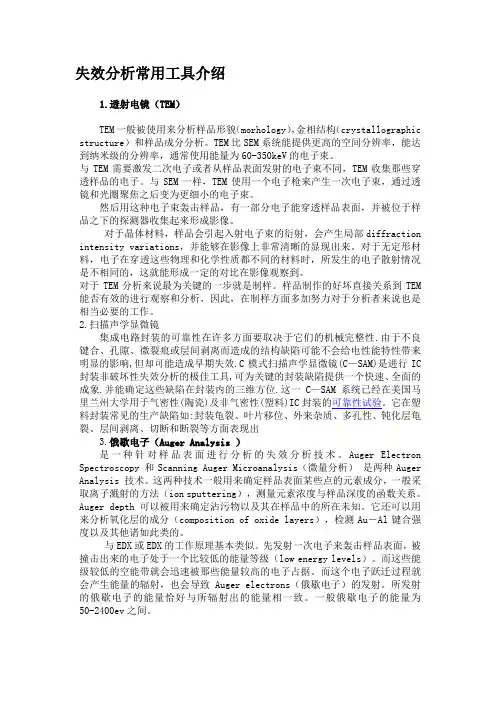
失效分析常用工具介绍1.透射电镜(TEM)TEM一般被使用来分析样品形貌(morhology),金相结构(crystallographic structure)和样品成分分析。
TEM比SEM系统能提供更高的空间分辨率,能达到纳米级的分辨率,通常使用能量为60-350keV的电子束。
与TEM需要激发二次电子或者从样品表面发射的电子束不同,TEM收集那些穿透样品的电子。
与SEM一样,TEM使用一个电子枪来产生一次电子束,通过透镜和光圈聚焦之后变为更细小的电子束。
然后用这种电子束轰击样品,有一部分电子能穿透样品表面,并被位于样品之下的探测器收集起来形成影像。
对于晶体材料,样品会引起入射电子束的衍射,会产生局部diffraction intensity variations,并能够在影像上非常清晰的显现出来。
对于无定形材料,电子在穿透这些物理和化学性质都不同的材料时,所发生的电子散射情况是不相同的,这就能形成一定的对比在影像观察到。
对于TEM分析来说最为关键的一步就是制样。
样品制作的好坏直接关系到TEM 能否有效的进行观察和分析,因此,在制样方面多加努力对于分析者来说也是相当必要的工作。
2.扫描声学显微镜集成电路封装的可靠性在许多方面要取决于它们的机械完整性.由于不良键合、孔隙、微裂痕或层间剥离而造成的结构缺陷可能不会给电性能特性带来明显的影响,但却可能造成早期失效.C模式扫描声学显微镜(C—SAM)是进行IC 封装非破坏性失效分析的极佳工具,可为关键的封装缺陷提供一个快速、全面的成象.并能确定这些缺陷在封装内的三维方位.这一C—SAM系统已经在美国马里兰州大学用于气密性(陶瓷)及非气密性(塑料)IC封装的可靠性试验。
它在塑料封装常见的生产缺陷如:封装龟裂、叶片移位、外来杂质、多孔性、钝化层龟裂、层间剥离、切断和断裂等方面表现出3.俄歇电子(Auger Analysis )是一种针对样品表面进行分析的失效分析技术。
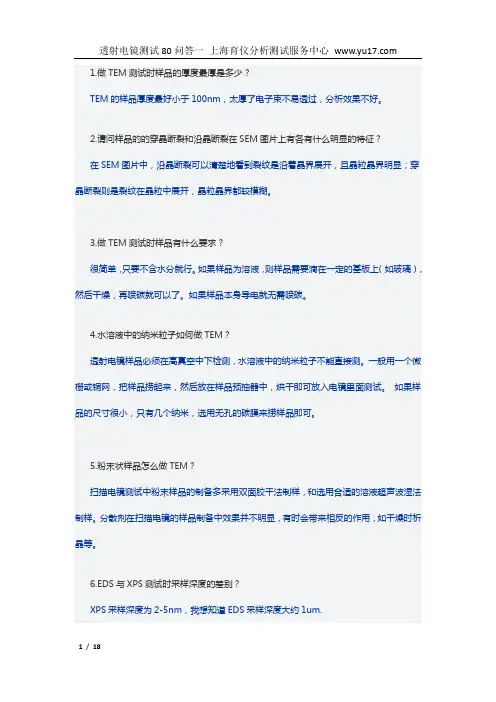
1.做TEM测试时样品的厚度最厚是多少 ?TEM的样品厚度最好小于100nm,太厚了电子束不易透过,分析效果不好。
2.请问样品的的穿晶断裂和沿晶断裂在SEM图片上有各有什么明显的特征?在SEM图片中,沿晶断裂可以清楚地看到裂纹是沿着晶界展开,且晶粒晶界明显;穿晶断裂则是裂纹在晶粒中展开,晶粒晶界都较模糊。
3.做TEM测试时样品有什么要求?很简单,只要不含水分就行。
如果样品为溶液,则样品需要滴在一定的基板上(如玻璃),然后干燥,再喷碳就可以了。
如果样品本身导电就无需喷碳。
4.水溶液中的纳米粒子如何做TEM?透射电镜样品必须在高真空中下检测,水溶液中的纳米粒子不能直接测。
一般用一个微栅或铜网,把样品捞起来,然后放在样品预抽器中,烘干即可放入电镜里面测试。
如果样品的尺寸很小,只有几个纳米,选用无孔的碳膜来捞样品即可。
5.粉末状样品怎么做TEM?扫描电镜测试中粉末样品的制备多采用双面胶干法制样,和选用合适的溶液超声波湿法制样。
分散剂在扫描电镜的样品制备中效果并不明显,有时会带来相反的作用,如干燥时析晶等。
6.EDS与XPS测试时采样深度的差别?XPS采样深度为2-5nm,我想知道EDS采样深度大约1um.7.能谱,有的叫EDS,也有的叫EDX,到底哪个更合适一些?能谱的全称是:Energy-dispersive X-ray spectroscopy国际标准化术语:EDS-能谱仪EDX-能谱学8.TEM用铜网的孔洞尺寸多大?捞粉体常用的有碳支持膜和小孔微栅,小孔微栅上其实也有一层超薄的碳膜。
拍高分辨的,试样的厚度最好要控制在 20 nm以下,所以一般直径小于20nm的粉体才直接捞,颗粒再大的话最好是包埋后离子减薄。
9.在透射电镜上观察到纳米晶,在纳米晶的周围有非晶态的区域,我想对非晶态的区域升温或者给予一定的电压(电流),使其发生变化, 原位观察起变化情况?用原子力显微镜应该可以解决这个问题。
10.Mg-Al合金怎么做SEM,二次电子的?这种样品的正确测法应该是先抛光,再腐蚀。

探讨用sem_eds分析材料的碳含量篇一:SEmEdSSEm、EdS一、实验目的1、了解扫描电镜和能谱仪的基本结构与原理2、掌握扫描电镜和能谱仪样品的准备与制备方法3、掌握扫描电镜和能谱仪的基本操作步骤4、了解实验结果的分析与讨论二、实验原理1、扫描电镜的工作原理扫描电镜是用极细的电子束在样品表面扫描,将产生的二次电子用特制的探测器收集,形成电信号运送到显像管,在荧光屏上显示物体的外观形貌。
图1扫描电镜示意图从电子枪阴极发出的直径几个纳米的电子束,受到阴阳极之间加速电压的作用,射向镜筒,经过聚光镜及物镜的会聚作用,缩小成直径约几毫微米的电子探针。
在物镜上部的扫描线圈的作用下,电子探针在样品表面作光栅状扫描并且激发出多种电子信号。
这些电子信号被相应的检测器检测,经过放大、转换,变成电压信号,最后被送到显像管的栅极上并且调制显像管的亮度。
显像管中的电子束在荧光屏上也作光栅状扫描,并且这种扫描运动与样品表面的电子束的扫描运动严格同步,这样即获得衬度与所接收信号强度相对应的扫描电子像,这种图象反映了样品表面的形貌特征。
2、X射线能谱分析原理X射线能量色散谱分析方法是电子显微技术最基本和一直使用的,具有成分分析功能的方法,通常称为X射线能谱分析法,简称EdS或EdX方法。
利用EdS可以在10s以内把试样里所含的浓度在10%(重量百分比)以上所有能量高于1Kev的元素分析出来,并可以在100s 之内把微量到0.5%的元素分析出来。
图2EdS系统框图a、X射线经过薄铍窗进入一个反向偏压的被浸在液氮里冷却的锂漂移硅晶体,这个晶体把X射线能量转换成电荷脉冲;b、电荷脉冲由前置放大器转换成电压脉冲,放大后通过电缆把脉冲信号送到脉冲处理器中去,在处理器中进一步放大;c、放大后的信号由模/数转换器转换成数字信号,并被送入多道分析器,由荧光屏显示出来;d、经多道分析器的信号同时经电脑处理,成为我们需要的数据。
三、主要仪器设备及耗材1、KYKY1000B扫描电镜2、JdS2300X射线色散能谱分析仪3、SBc—12离子溅射仪(样品喷涂导电层用)4、银导电胶、双面胶(制样用)四、实验步骤1、SEm的操作步骤:(一)制样对所测的样品进行简单的清洗干燥,对表面不带电、导电性能差的样品在用扫描电镜观察时,当入射电子束打到样品上,会在样品表面产生电荷的积累,形成充电和放电效应,影响对图象的观察和拍照记录。
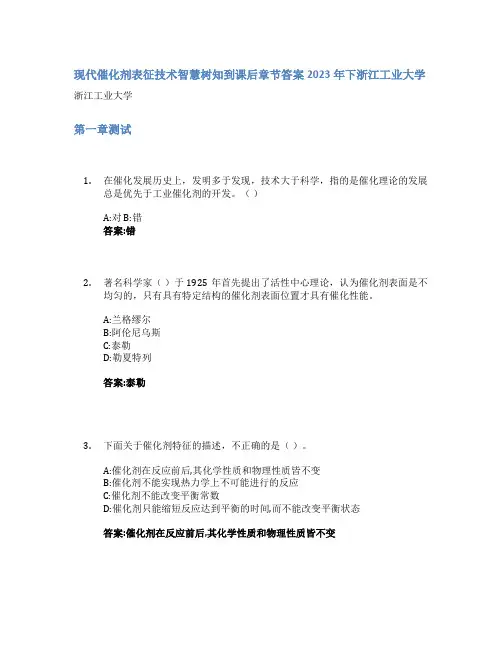
现代催化剂表征技术智慧树知到课后章节答案2023年下浙江工业大学浙江工业大学第一章测试1.在催化发展历史上,发明多于发现,技术大于科学,指的是催化理论的发展总是优先于工业催化剂的开发。
()A:对 B:错答案:错2.著名科学家()于1925年首先提出了活性中心理论,认为催化剂表面是不均匀的,只有具有特定结构的催化剂表面位置才具有催化性能。
A:兰格缪尔B:阿伦尼乌斯C:泰勒D:勒夏特列答案:泰勒3.下面关于催化剂特征的描述,不正确的是()。
A:催化剂在反应前后,其化学性质和物理性质皆不变B:催化剂不能实现热力学上不可能进行的反应C:催化剂不能改变平衡常数D:催化剂只能缩短反应达到平衡的时间,而不能改变平衡状态答案:催化剂在反应前后,其化学性质和物理性质皆不变4.催化剂表征技术的发展方向为()。
A:逐渐从宏观尺度向纳米尺度,甚至原子尺度发展B:逐渐从空间分辨向时间分辨的方向发展C:逐渐从静态的表征技术向原位动态的表征技术发展D:逐渐从工业催化体系向模型催化体系发展答案:逐渐从宏观尺度向纳米尺度,甚至原子尺度发展;逐渐从静态的表征技术向原位动态的表征技术发展5.可以研究催化剂的孔结构的表征技术有()A:氮气吸附B:XRDC:IRD:TEM答案:氮气吸附;XRD;TEM第二章测试ngmuir吸附是()A:单分子层吸附B:既有单分子层吸附又有多分子层吸附C:多分子层吸附答案:单分子层吸附2.物理吸附是吸附剂和吸附质之间靠分子间作用力发生吸附作用;化学吸附是吸附剂和吸附质之间形成()发生吸附作用。
A:分子引力B:离子键C:范德华力D:化学键答案:化学键3.以下的说法中符合Langmuir吸附理论基本假定的是()。
A:固体表面是均匀的,各处的吸附能力相同B:吸附热与吸附的位置和覆盖度有关C:吸附分子层可以是单分子层或多分子层D:被吸附分子间有作用,互相影响答案:固体表面是均匀的,各处的吸附能力相同4.下面关于BET公式中C值描述正确的是()。
tem-edx 波峰强度-概述说明以及解释1.引言1.1 概述TEM-EDX(Transmission Electron Microscopy-Energy Dispersive X-ray Spectroscopy)是一种结合透射电子显微镜和能谱仪的先进分析技术。
通过TEM-EDX能够获得物质的微观结构和化学成分信息,为材料科学、纳米技术、生物学等领域的研究提供了重要的帮助。
波峰强度作为TEM-EDX技术中的一个重要参数,可以反映样品中不同元素的含量。
了解波峰强度可以帮助我们更准确地分析样品的成分,从而为材料的研究和应用提供更详细的信息。
在本文中,我们将深入探讨波峰强度的含义、影响因素以及其在实际应用中的重要性。
1.2 文章结构文章结构部分是关于整篇文章的结构和组织方式的介绍。
在这一部分,我会简要介绍本文的章节安排和内容概述,以帮助读者更好地理解文章的大致脉络。
文章结构包括引入与结束,以及中间态结构,先引入主要论点,再详细探究和论述,最后总结得出结论。
在本文中,文章结构将分为三大部分:引言、正文和结论。
在引言部分,将进行文章的引出和背景介绍,包括TEM-EDX技术的基本概念和应用背景。
进一步介绍文章的结构和目的,为读者提供阅读全文的导向。
在正文部分,将详细阐述TEM-EDX技术以及波峰强度的含义和影响因素。
通过详细的解释和案例分析,读者将更好地了解这一主题。
在结论部分,将对全文进行总结,并展望TEM-EDX波峰强度在未来的应用前景。
通过本文的阐述,读者将对这一技术有更深入的了解,并对未来的发展方向有一定的预期。
这就是本文的文章结构部分的内容,通过这样的章节安排和内容概述,读者将更好地理解整篇文章的内容和逻辑。
1.3 目的:本文旨在探讨TEM-EDX中波峰强度的概念、作用机制以及影响因素,以帮助读者更深入地理解这一分析技术中重要的参数。
通过对波峰强度的研究,可以更好地指导实验工作和数据分析,提高样品分析的准确性和可靠性。
证实固溶体生成的表征
固溶体的生成可以通过以下几种方法进行表征:
1. X射线衍射分析(XRD):可以用来确定固溶体的晶体结构和晶体学参数。
X射线衍射可以通过分析材料的衍射图样,确定晶胞参数、晶胞对称性和晶体结构。
2. 扫描电子显微镜(SEM):可以用来观察固溶体的表面形貌和组织结构。
SEM可以提供高分辨率的表面形态和结构信息,帮助确定固溶体的形貌和微观结构。
3. 透射电子显微镜(TEM):可以用来观察固溶体的内部结构和晶格缺陷。
TEM可以提供更高分辨率的像像和晶体缺陷信息,帮助分析固溶体的微观结构。
4. 能谱分析(EDX):可以用来确定固溶体中元素的成分和含量。
EDX可以通过分析材料的能谱,确定元素的存在和相对含量。
5. 差示扫描量热仪(DSC):可以用来确定固溶体的热性能和热稳定性。
DSC可以通过测量样品的热力学性质,如熔融温度、热流变行为等,来表征固溶体的热性能。
这些方法和技术可以综合使用,以全面地表征固溶体的成分、结构、形貌和性能。
edx能谱 error 指质量百分数开始的时候能谱的缩写有很多,比如EDS,EDX,EDAX等,大家对此也都心照不宣,知道ED就是Energy Dispersive,后面因为X-ray Analysis和Spectrum这几个词的不同用法,导致了缩写的不同。
而且相应的汉译也有很多,比如能量色散谱,能量散射谱等等。
大概是2004年左右,相关协会规定,EDS就是能谱或者能谱仪,EDX呢,就是能谱学,Dispersive就不去翻译。
这样EDS就应该是文章里的正规用法,而现在有很多文章仍然使用其他说法,有约定俗成的味道,大家知道怎么回事就行了。
2.TEM的能谱误差比SEM的小。
因为很多人知道TEM的分辨率高,所以认为TEM所配能谱的分辨率高于SEM。
这可以说是一个非常错误的论断。
同样厂家的能谱,同一时期的产品,用于TEM的分辨率通常要低于SEM几个eV,诚然,TEM可能会观察到更小的细节,但这只是能谱分析范围的精准,并不代表能谱的分辨率高。
SEM的样品比较容易制备,而且跟厚度关系不大,一般电子束深入样品的高度为几个微米,定量时可以放相应样品的标样(比如纯Si就用纯Si标样,MgO就用MgO标样,有很多国家级标样供选择)来做校正。
比较重的元素诸如很多金属和稀土元素的分析结果可以认为是定量的。
上海硅酸盐研究所的李香庭教授对SEM和电子探针的EDS分析结果做过比较系统的讲述,我摘抄如下:EDS分析的最低含量是0.×%(注:这个X是因元素不同而有所变化的。
)“电子探针和扫描电镜X射线能谱定量分析通则“国家标准,规定了EDS的定量分析的允许误差(不包括含超轻元素的试样)。
对平坦的无水、致密、稳定和导电良好的试样,定量分析总量误差小于±3%。
TEM 使用中的问题1. 用TIA 软件能不能一次打开一个文件夹里的所有数据,而不是一次只能打开一个?可以。
你可以将TIA 软件打开后,然后打开你想打开的文件的文件夹,选中你想打开的文件,用鼠标直接拖到TIA 软件界面,那么所有你拖过去的文件都直接全部打开了。
2. 做EDX 时能不能在采集图谱出现峰的过程中直接能显示出对应元素,不用切换到TIA 用Peak ID 才能知道元素成分?在Acquisition 模式下,TIA 软件的右边有一排小的按钮,是EDX Quant 的快捷键,将鼠标放到小按钮上等一下,你会看到快捷键是做什么的,你直接点快捷键就可以显示Peak ID 了,不必切换到analysis 模式。
3. EDX 中做元素含量分析结果中的K-factor 有啥物理意义?()()BA B A A B AB A a Q A a Q k εεωω= 其中Q = ionization cross-sectionω = fluorescence yielda = relative transition probability =A = atomic weighte = detector efficiency所以k-factor 主要是与原子序数有关的因素。
4. 做STM 时LM 模式下调清晰后转到STEM 模式相同倍数为什么图像不清晰了?这个有可能是由于LM-STEM 的时候objective lens 是off 状态,切换到普通STEM 模式时,objective lens 是ON 的状态。
可能跟LM-STEM 的alignment 有关。
5. EDX 做线扫时,两个点最近距离是多少纳米仍然能够打准?电子束的束斑大约是多大?电子束斑的大小跟你所用的spot size 有关。
比如说spot size 9的时候束斑只有零点几个纳米,可是spot size 4-5时可能就是几个纳米了。
一般5 nm 没有问题。
电子能量损失谱研究钛硅分子筛中钛的存在状态郑爱国;向彦娟;朱斌;张进;林民;徐广通【摘要】利用透射电子显微技术(TEM)、X射线能谱技术(EDX)以及电子能量损失谱技术(EELS)对Ti原子是否进人到TS-1钛硅分子筛骨架进行了研究.结果表明,TS-1钛硅分子筛中存在的微量TiO2粒子的EELS信号中O-K边与Ti-L2边的能量差为70 eV左右;而钛硅分子筛(TS)粒子的EELS信号中O-K边与Ti-L2边的能量差为79 eV左右.对比TiO2、TS粒子的EELS,发现TS粒子的Ti-L2、Ti-L3边与TiO2粒子的Ti-L2、Ti-L3边的能量差为1 eV,这种能量差异可以作为Ti原子进入TS-1钛硅分子筛骨架的一种证明.%The transmission electron microscopy (TEM), X-ray energy dispersive spectroscopy (EDX) and electron energy loss spectroscopy(EELS) were used to analyze if the Ti atoms engaged into the framework of titanium silicalites zeolite (TS-1). The results showed that the difference between O-K and Ti-Lz was about 70 eV for TiO2 , while it was about 79 eV for TS particles. Compared the EELS of TiO2 with that of TS particles, it was found that the difference between Ti-L2 and Ti-L3 in TiO2 and TS particles was 1 eV, which could be a proof for Ti atoms engaging into the framework of TS-1.【期刊名称】《石油学报(石油加工)》【年(卷),期】2012(028)006【总页数】4页(P991-994)【关键词】钛硅分子筛(TS-1);电子能量损失谱(EELS);透射电子显微技术(TEM);X射线能谱技术(EDX)【作者】郑爱国;向彦娟;朱斌;张进;林民;徐广通【作者单位】中国石化石油化工科学研究院,北京100083;中国石化石油化工科学研究院,北京100083;中国石化石油化工科学研究院,北京100083;中国石化石油化工科学研究院,北京100083;中国石化石油化工科学研究院,北京100083;中国石化石油化工科学研究院,北京100083【正文语种】中文【中图分类】TE624.4钛硅分子筛(TS-1)是1983年由意大利Enichem公司[1]首次合成的新一代高效催化氧化催化剂,兼有钛的氧化性和分子筛的择形性。